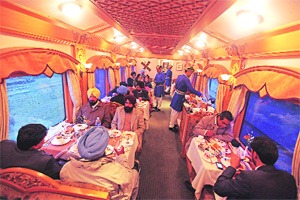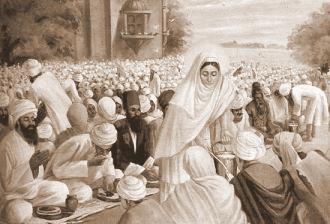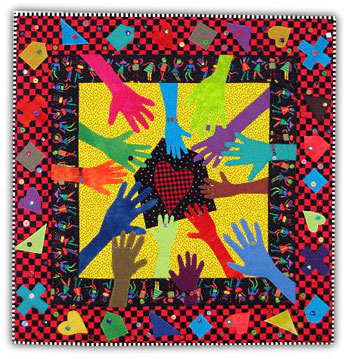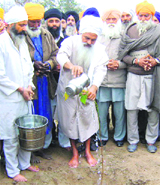

Image: Copyright Saffron Press
As a very proud Masi, I often find myself wondering how we can make events such as Vaisakhi, more meaningful for the next generation. Why is it that we exchange cards and gifts during Christmas, and yet for Vaisakhi, a Facebook status update suffices? While I fully support children exploring and participating in global celebrations, I think it is just as important (perhaps more so) that Sikh children are raised celebrating Vaisakhi in a similarly joyful way. For Sikhs living in the diaspora, Vaisakhi is often associated with nagar kirtans, melas, and gurdwara visits. This is a great way for children to celebrate the occasion with the community, however, I am not sure the event really resonates with them.
For example, did you know about the significance of kite flying during Vaisakhi?
The spring air of Vaisakh makes kite flying a popular pass time. A kite is called a Patang or Guddi Manjha in Panjab. The wood and bamboo roll on which the string is wound is called a Charkhadi. Children often give their kites a special name to reflect their personal designs such as: Pari (fairy), Chand Mama (man-in-the-moon/uncle moon), Shakkar Para (a panjabi sweet). Poetry may also be written in Panjabi on the Patang to send messages to a special person up on the roof. [link]
How fun would it be to have kite flying events for Sikh children? They could invite their non-Sikh friends and use it as a way to share their heritage. Don’t get me wrong, I think it’s important not to commercialize historical occasions – however, we have to be willing to celebrate our history so that it is meaningful. So I’m curious – what does Vaisakhi mean to you and how do you celebrate it? How would you like your children, your nieces or nephews to remember Vaisakhi? Or if you are a parent, how do you make Vaisakhi meaningful for your children?
Here is a useful document for parents and educators, describing ways to celebrate Vaisakhi with children. Happy Vaisakhi!
Advocates of gay rights celebrated after the Obama administration in late February said that it would no longer support the Defense of Marriage Act, a federal law that bans the recognition of same-sex marriage. The Defense of Marriage Act, or DOMA, signed into law by President Clinton in 1996, defines marriage as a legal union between one man and one woman.
The Obama administration, however, believes DOMA is unconstitutional.
President Barack Obama has concluded that the administration cannot defend the federal law that defines marriage as only between a man and a woman. He noted that the congressional debate during passage of the Defense of Marriage Act “contains numerous expressions reflecting moral disapproval of gays and lesbians and their intimate and family relationships – precisely the kind of stereotype-based thinking and animus the (Constitution’s) Equal Protection Clause is designed to guard against.” (link)
Although I take issue with the state having a role in defining what is and isn’t a legitimate relationship in general (and one’s romantic relationship defining whether or not they get access to certain benefits and privileges), I applaud the administration taking this strong stance against homophobic bigotry. So, I was disappointed (though not terribly surprised) to hear that the World Sikh Council, a “representative and elected body of Sikh Gurdwaras and institutions in the US,” has been lobbying the Obama administration to uphold DOMA and went so far as to co-sign a letter of protest to President Obama denouncing his decision to reverse DOMA. The letter states:
Guest blogged by Tarnjit Kaur
This essay was written as an introduction to ‘Sikhism and Gender Equality: Where do you See Yourself?,’ an event to be held in Ontario Saturday, April 2nd at 6 pm. All are welcome to attend.
Motivated by the empowering message of Sikh theology, Sikhi, Sikh history is replete with struggles against all forms of oppression, to protect religious freedoms, human rights and in the pursuit of self-determination. Although an expression often confined to an interpretation of Christianity, I have always thought of Sikh theology as a form of liberation theology: a theology that liberates in the here and now from social, political and economic injustices. It is from this perspective that I ask whether if a Sikh thealogy [1], that is a Sikh feminist theology, has political and social utility in advancing the cause for gender equality within the Sikh communities [2].
I argue that women’s oppression due to patriarchy is compounded by colonial factors and that the disconnect between the practise and theory of Sikhi is entrenched in socio-economic and political inequities. It is therefore seriously questionable whether there is any political utility in the efforts to reclaim the ”feminine voice” or the feminist nature of Sikh scripture as subscribed by Sikh thealogy [3]. I further ask how can gender equality be achieved? Does Sikhi empower women because of its emphasis on traditional gender roles and femininity? Or does Sikhi advocate that men should no longer exploit their own privilege arising from their status as men? Or are there clear messages of gender egalitarianism promoting gender equality? These are areas of Sikh thealogy that are pregnant for research, scriptural analysis and historical investigation and are part of a larger on-going work both within the academic sphere and by grass-roots Sikh organizations.
If you haven’t heard yet, March 14th, the First of the month of Chet in the Nanakshahi Calendar is being commemorated by Sikhs across six continents as ‘Sikh Vatavaran Diwas,’ or Sikh Environment Day.
Following an official statement from the Akal Takht, this week over 250 Gurdwaras, schools, and Sikh organizations around the world, along with Takht Sri Kesgarh Sahib and Takht Sri Hazur Sahib, will focus kirtan and katha on ‘kudrat’, host tree plantings, clean ups, nagar kirtans, children’s art displays, and Khalsa school lessons on the theme of the environment.
Here’s a video taken of the British Columbia sangat during an entire weekend of successful events organized by the Sikh Green Team, in conjunction with the Guru Nanak Sikh Gurdwara and Sukh Sagar Gurdwara Sahib. Sarya Nu Sri Guru Har Rai Sahib Ji de Gurgaddi Diwas Di Lakh Lakh Vadhaiyan Hove!

Like many Sikhs, I grew up eating meat. It was something I never really questioned until I was in college and started learning more about the treatment of animals on factory farms and the environmental impact of the meat industry.
But growing up I never thought about where my spicy deep-fried chicken strips were coming from. Or the living (and dying) conditions of the cow that made up the thinly sliced pieces of meat in my Arby’s roast beef sandwich. As long is it wasn’t halal, it was all good.
I never understood what halal truly meant, but the message I got from my parents and others in the community went something like this: Halal is the way Muslims slaughter animals, and it involves killing the animal slowly and painfully. And lots of gushing blood. We Sikhs don’t believe in torturing animals, so we don’t eat halal meat. Sound like a familiar story line?
This, of course, contributed to my perception of Muslims as barbaric people who were dirty, had multiple wives and questionable morals, and killed my ancestors during partition. In the context of the messages I received from family and community growing up, the story about halal fit right in – yet another way Muslims are backwards.
As is abundantly clear in my writing on this blog, this is in stark contrast to how I see Islam and the Muslim community at this point in my life. But I grew up with these messages and stereotypes just like most of my Sikh peers did.
Really, what’s all the fuss about halal? Why aren’t Sikhs supposed to eat halal meat?
I just came across a great article on the work of Baba Sewa Singh of Khadoor Sahib, Amritsar District, and his remarkable campaign to plant trees across rural Punjab. Well worth a read.
According to [Baba Sewa Singh], they will adopt another 100 villages this year in Bathinda, Jalandhar, Patiala, Amritsar, Gurdaspur and Tarn Taran districts. “We are targeting plantation of at least 500 trees in each village, which would make a total of 50,000 trees in 100 villages every year,” he added.
Forests are vital to maintaining ecological balance in air, water and soils across Punjab. At present, only 6.5 percent of Punjab is under forests, which is even lower than the desert state of Rajasthan at 9.5 percent. Though the Punjab government plans to increase forest cover to 15 percent by 2017, ensuring that forests benefit the average person in Punjab will an important indicator of success in any afforestation effort financed by the state. Planting indigenous and native species like kikar, tahli, jamun, and neem trees, along with fruit trees in homes across villages will help ensure that the benefits derived from healthy, productive forests reach the many who still live in Punjab’s rural areas.
Since the Green Revolution was introduced in the mid-1960s, the Sikh spiritual homeland of Punjab has been faced with mounting soil erosion, water table decline, widespread chemical contamination, and continued loss of biodiversity in agriculture and forests. The Cold War era anti-revolutionary plan transformed Punjab into the breadbasket of the Indian nation state but left Punjab’s ecology in a critical state and set the agricultural economy on a path of long-term decline. Without Sikh institutions on board with the ecological reality of Punjab, the serious degeneration of the environment will continue to accelerate, and the marginalized and the poor will burden the costs of shortsighted statist policies that have exploited the natural resources of Punjab.
The week of March 14, the Gurpurab of Guru Har Rai Ji, Gurudwaras across Punjab and the Diaspora will participate in the first ever global day of reflection on the environment to reach the masses in Punjab and the world. On ‘Sikh Environment Day’ Gurdwaras across the world will focus kirtan and katha on the environment, participate in tree plantings, install environmental notice boards, start pesticide-free vegetable gardens, and host Khalsa School lessons on the environment. The SGPC, DSGPC, AGPC, are all in support of this day and celebrations will be underway at Anandpur Sahib (‘pani bachao, rukh lagao!’). We have prepared a Gurdwara Guide and shabad compilation for participating Gurudwaras and the Sikh Research Institute has also created Sikh environmental education lesson for Khalsa Schools across the diaspora.
Major outreach efforts are underway across the world, but WE NEED YOU to invite your Gurudwaras to join Sikhs across the world. Please take ten minutes of your day, ‘like’ EcoSikh on facebook, download an English or Punjabi versions of our invitations, pass them on to your Gurudwara heads, and encourage your Gurudwara to REGISTER today. We can make this happen for the future generations and create a shift in thinking on the serious degradation of Punjab’s rural and urban ecology before the process becomes irreversible.
Please visit www.ecosikh.org to learn more about Sikhism’s contribution to a sustainable future. May the Khalsa ever remain spiritually exalted, and always in service of humanity.
On a recent visit to Amritsar, one of the topics of interest was the newly approved plan by Chief Minister Badal for the revamping of the entrance to the Darbar Sahib. The plan includes a “state-of-art” restructuring of the entrance plaza.
According to one article, the new entrance would address accessibility for pedestrians and eco sustainability. It was also noted in this article that a timeline for completion and budget for this project has not been planned.
While the Panjab government is clearly looking to increase their tourism value, it was made clear to me that many Panjabis are not huge supporters of a project that will change the existing architecture around the Darbar Sahib. There is a strong sentiment that religious buildings should be treated as such, rather than as tourist spots.
The Darbar Sahib complex does rely on funds to ensure sustainability but with plans to enhance the Darbar Sahib with tourism in mind, the Panjab government will be treading a fine line to make sure that the holiest of places for Sikhs does not become impacted by visitors. Nevertheless, the Darbar Sahib is not the first place to be affected by increased tourism. Other “wonders” around the world are also working to address how to balance the sustainability of history with the growing inquisition of visitors.
What do you think? Should the Darbar Sahib be redesigned with tourism in mind or should efforts be made to keep the area intact as an important religious place?
Guest blogged by Hunny Singh
Recently I went home to the East Coast and had som e inspirational time with my family. While snowy conditions prevailed outside, inside the house, a pizza soon to be shared joined a confused and yet open love for a dance. I had an interaction with my mother that got me wanting to share with y’all. Here’s the story…
e inspirational time with my family. While snowy conditions prevailed outside, inside the house, a pizza soon to be shared joined a confused and yet open love for a dance. I had an interaction with my mother that got me wanting to share with y’all. Here’s the story…
As Ma Ji pokes her head out from behind the curtains, she pauses ever so slightly, and says:
“Remember the Guru with every passing day.”
She returns to being with the Sri Guru Granth Sahib, glasses on, focused gaze settling back in. Especially endearing to me are her engaged brows, lifted eyelashes, and soft thought.
In the dim light, I see the reflections of the Guru’s words bringing meaning upon her eyes.
Yup, I’ve seen that look before so many times.
She is in Baba Ji’s room.
I don’t remember when the Baba Ji’s* room became a part of our house and our lives, but I do remember it always being there. That’s the only name I have ever known for the room. I think this room is something that many Sikh folks share, in some way or form–a special intimate space.
 A luxury train, costing about $10,000 per passenger, and traveling to the five takhts throughout India has begun it’s journey. The nine-day trip will begin in New Delhi and will stop at Keshgarh Sahib, the Akal Takht, Damdama Sahib, Hazoor Sahib and Patna Sahib.
A luxury train, costing about $10,000 per passenger, and traveling to the five takhts throughout India has begun it’s journey. The nine-day trip will begin in New Delhi and will stop at Keshgarh Sahib, the Akal Takht, Damdama Sahib, Hazoor Sahib and Patna Sahib.
The 21-coach train includes two presidential suites, five-star rooms, a spa, a salon, gym, two restaurants, a conference hall and a business center! [link] There are currently 88 passengers on board from both India and abroad including the US, Canada, the UK, Germany and France. The trip is being managed by the Taj group of hotels.
It sounds like the trip is not necessarily directed towards Sikhs and is not simply a “pilgrimage” but apparently will include additional stops in Rajasthan for sightseeing. One article notes that,
Different legs of the journey will have performances by traditional artists onboard. “Kirtans” (holy songs of Sikhs) by Sikh hymn singers called Raagis will also be an attraction.
The next trip is planned for March 2011 with an ultimate goal of doing four trips a year. What are your thoughts – would you pay $10,000 for a trip like this?
Last week I attended a diwan of about 50 people on a Thursday night on the east side of Manhattan, in New York City. The Manhattan Sikh Association (MSA) has been organizing monthly diwans in NYC for years now in apartment buildings and other temporary locations, but recently the group opened up a permanent space on East 30th street and Park avenue in Manhattan, making it the island of 2 million inhabitants’ first gurdwara.
I’ve always enjoyed attending the intimate MSA diwans, which tend to attract a lot of young Sikh professionals who live or work in Manhattan and the surrounding areas. Even the New York Times was intrigued by MSA and did a story on them last year. As I sat in their new space last Thursday, I felt calm and at peace, no one was yelling at me about the latest gurdwara politics**, and my peers, many of whom were second generation Americans like myself, were the ones doing kirtan, leading Rehras Sahib and Ardas, and in short, running the show. One young Sikh did a brief and conversational viakhia (commentary) in English of his shabad before he started singing. I thought to myself, this is a spiritual space.
Sadly, a spiritual space for sangat to come together, reflect and grow is a far stretch from what most gurdwaras I’ve attended in North America feel like.
Though Sikhs have settled all around the world, roughly 20 million Sikhs still reside in Punjab. There, and elsewhere, Sikhs are facing serious problems including, but not limited to: farmer suicide, female infanticide, drugs and alcohol abuse, domestic violence, economic disasters, disease, poverty, illiteracy, and much more. [Lahir Press Release]
Many of my most recent posts have been about upcoming events happening in the Sikh Community. I think this is a positive sign – that rather than idly discussing and debating issues that inflict our panth, we are actually doing something about it! I would like to highlight two upcoming events occurring in North America. These platforms will bring together talented youth to raise awareness and by doing so, will aim to address important issues within our community. Please support these endeavors so that we can continue to move our panth in the right direction.
Lahir: Save Punjab. Save Ourselves | New Jersey | November 20th | 6pm
Lahir: Move the Movement 2010 is a night of spoken word, poetry, music, and the arts. Artists will include G.N.E., Hoodini, Mandeep Sethi, Gunjiv “Baagi” Singh, MC G-Singh and Humble the Poet. The event will kickoff the movement to respect and protect Punjab by donating all profits to the Baba Nanak Education Society (BNES), an organization which provides humanitarian assistance in rural Punjab to next of kin of suicide victims. These are families with small children left completely destitute by the death of bread-winners and have been neglected by the government. A donation of approximately $350 can help support one family for a year. For more information, visit the facebook page.

Guest blog by: Satinderpal Kaur
This August the 12th annual Camp Gian, in which approximately 150 youth ages 3 to 20 partook, was held. In its twelfth year, Camp Gian had a new home, the Khalsa Care Foundation, but still had the same mission. Youth attended the overnight camp from August 8th through August 13th and spent five days being instilled with “gian”—knowledge—in various forms. While learning about the history of the period from 1740 to 1850, the youth also learned about discipline, spiritual growth, being part of a “sangat” (congregation/ community), and leadership through various activities throughout the week.
Every morning, campers would be woken up as early as 4:00 a.m. in order to get the day started on time. All of the campers would join each other in the main hall for yoga exercises in order to get their bodies ready for the day. The exercises were followed by recitation of the morning prayers, Jap Ji Sahib, Jaap Sahib, and Savaiye, as well as singing of kirtan. During the morning, as well as the evening, divaans all of the activities are facilitated by campers so that they learn how to perform the services that occur at gurdwara. The campers are responsible for making the prashaad, doing ardaas, taking hukam, and handing out prashaad. The theme shabad for this year was “Darshan Har Dekhan Kai Taaee” and the theme song was entitled “I Can’t Wait to See You.” Every year a shabad is chosen to go hand in hand with the history lessons and a theme, or take-home message, is developed. Waking up in the morning and participating in the morning divaan instilled values of self-discipline and personal, spiritual growth in the campers.
And some brave Sikhs that won’t buckle for the whims of one self-righteous judge.
Bolay So Nihal! Sat Sri Akal!

 The concept of langar is probably one of the most unique aspects of the Sikh faith. For hundreds of years now, Sikhs have carried on this tradition which was first started by Guru Nanak Dev Ji and later institutionalized by Guru Amar Das Ji. W.O. Cole, who studies Sikhi, states “…, the unique concept of universality and the system of Langar (free community meal) in Sikhism are the two features that attract me towards the study of Sikhism. Langar is the exclusive feature of Sikhism and found nowhere else in the world.”
The concept of langar is probably one of the most unique aspects of the Sikh faith. For hundreds of years now, Sikhs have carried on this tradition which was first started by Guru Nanak Dev Ji and later institutionalized by Guru Amar Das Ji. W.O. Cole, who studies Sikhi, states “…, the unique concept of universality and the system of Langar (free community meal) in Sikhism are the two features that attract me towards the study of Sikhism. Langar is the exclusive feature of Sikhism and found nowhere else in the world.”
There are essentially two elements of langar. One is clear in its definition of free kitchen and the tradition of expressing the ethics of sharing, community, inclusiveness and oneness of all humankind. The second element is that langar should be simple. The cost of langar is covered by voluntary donations from the sangat and is made through the hands of seva.
Today, langar has transformed into (as some people joke) “the dollar buffet.” I don’t find this joke to be amusing at all. Everytime I go into a gurdwara now, I am overloaded by the amount of food which is made (and often times wasted). Langar was meant to be simple – probably so that we could feed the most amount of people in the most efficient manner. Everyone wants their langar to be the most complimented and delicious meal but too often we forget that is not the intention.
We want the sangat to participate in langar seva and we want them to be able to afford to do so. Let’s not add the adverse health impact of food we serve in gurdwaras today to this equation. If our standard today is that langar should include lavish spreads at breakfast time and lunch time, I am not surprised why gurdwaras need to constantly ask the sangat to please do langar seva. Let’s keep the costs down and encourage the making of simple langars and this way, all community members (not just middle and upper class Sikhs) have an opportunity to do this seva.
An interesting read on the Sociology of Langar can be found here.
Happy Mother’s Day to all the wonderful mother’s who have nourished our physical bodies with food made out of love and nurtured our souls with their warm spirits.
I leave you with one of Satinder Sartaaj’s most beautiful songs, “Ammi”. Among all the many Punjabi songs about mothers, Sartaaj has brought us one of the best. He captures a mother’s spirit and it’s priceless value to not only children but the world.

As we celebrate motherhood today, let’s also remember the value of the girl child. Guru Nanak Ji reminds us in Raaj Aasaa on Pannaa 473:
Guest blogged by Jind Kaur
For my inaugural [guest] post on The Langar Hall, I wanted to discuss something that is often on my mind when I think about our faith and how to practice it: the concept of sangat (the congregation). The Guru Sahibaan often impressed upon us how we should not isolate ourselves from the world in order to find salvation. We are taught that we must live amongst the world, and it is from the sangat where we learn and practice the teachings the Gurus pass on to us. “Satsangat Satgur Chattsaal Hai, Jit Har Gunh Sikha” “The Sat Sangat, the True Congregation of the True Guru, is the school of the soul, where the Glorious Virtues of the Lord are studied.” Participation and engagement with the sangat is considered essential for a Sikh’s spiritual progress. It is in the sangat that we worship and in the sangat where we are to receive training in our faith and its daily application. The sangat is our holy fellowship where we may become morally elevated.
But where is our sangat? Is our sangat in our Gurudwara, out in the world or some combination of both? Sometimes when I see the current state of our Gurudwaras, regardless of geography, it makes me want to stay home to pray quietly by myself and find other ways to do seva where it is needed. There is an epidemic of politics overtaking our Gurudwaras. However, this is enabled and encouraged by the absence of a true sangat.
When I was a teenager attending a particular Sikh camp, (I don’t want to date myself), I attended a lecture/discussion that has permanently imprinted itself in my mind. The man who led the discussion taught us about the root of the word “sangat” – this is “sang” (pronounced “sung”), which means “together”. Your sangat consists of those whom you walk with together in life. This led me to ask, not only where my sangat is, but who is in that sangat.
Guest blogged by Brooklynwala
A few days ago, a friend sent me this powerful open letter she wrote in order to spark critical thinking and dialogue on the pitfalls of calling the police and relying on the criminal (in)justice system to deal with issues in our neighborhoods and communities. We live in New York City, which has a police force widely known for its excessive use of force and violence, especially against people of color. Sundari recently did a post on the NYPD shooting and killing of a Sikh man in NYC, Satnam Singh, just last week.
In a context in which police by and large cause more harm than get us closer to justice and where the prison system dehumanizes people instead of rehabilitating them, the author of this piece, along with a growing movement around the U.S., are challenging us to think of alternative ways of responding to harm. She states,
“Many of us don’t believe in calling the police. Right now, right here, even before we’ve sufficiently built all the alternative structures for responding to harm. Both in an attempt to create the world we want to live in, and/but also because the impact of prisons and policing is brutal, oppressive, racist, traumatic. We see almost no good coming of it, certainly no transformation, no making things better. We don’t trust police, we don’t think of them as the “good guys,” and we don’t think calling them is going to change anything.”
My friend’s compelling piece “Feeling for the edge of your imagination” got me thinking about what a Sikh approach to justice is. While there is clearly not a simple answer to this question, I tend to think a Gurmukh would place love, forgiveness, rehabilitation, accountability, and recognizing the Divine in all at the center, despite questionable or even horrific actions one has perpetrated. Think about Bhai Kanhaiya Ji’s seva for “enemy” soldiers in need, who saw the injured soldiers’ humanity before he sought vengeance for their attacks against the Sikhs.
 A few years back, I went to my first Charni Lagna ceremony. Charni Lagna – literally, “at the feet of the Guru” is the traditional name of the event where a Sikh formally begins reading from the Guru Granth Sahib.
A few years back, I went to my first Charni Lagna ceremony. Charni Lagna – literally, “at the feet of the Guru” is the traditional name of the event where a Sikh formally begins reading from the Guru Granth Sahib.
Like most Sikh ceremonies, it is actually quite simple. After shabad kirtan is recited, an ardaas is offered for the young (or old) Sikh who is beginning their journey with the Guru – then finally, he or she will read the hukamnama.
The ceremony I attended was for an 11-year old girl, who was very excited and worked hard to prepare for this day. After a few shabads were sung by the local jatha and the girl’s friends – one by one, members of the sangat came to say a few words of encouragement. One of her friends was around the same age and similarly went through this ceremony a year prior. She spoke about her own experience reading from the Guru Granth Sahib on a daily basis and how it has changed her life. Then one of her friends who had yet to take this step spoke of how she was inspired to do so soon. Then came her Punjabi school teacher, then her camp counselors, then other leaders of the community. I noted that neither her parents nor any of her relatives spoke – but instead, they just sat and listened to the members of the sangat, who individually shared such beautiful words of encouragement and praise for this young Kaur, who humbly sat at the feet of the Guru…It was quite powerful.
Finally, as the ardaas ended, there was a rare moment of pin-drop silence in the darbar hall. Then this brave 11 year old girl, surrounded by her proud parents and grandparents, read the hukamnama flawlessly…I was moved by the whole event.
Immediately after the hukmanama was completed, something remarkable happened…
Sikhs will be celebrating Vaisakhi world wide next week on April 14th. Sikhs in Malayasia are requesting that Vaisakhi be made a national holiday.
Tan Sri Darshan Singh, the President of Malaysia National Sikhs Movement president, said, “The Sikhs who arrived earlier in this country served in the security forces and have contributed towards the economic development of Malaysia”. Karpal Singh of DAP believes that Vaisakhi should be given consideration as a national holiday because of its considerable significance to Sikhs. However, Malaysian Sikhs have not gotten a positive response from the government.
A common saying is a community knows when its contributions are being viewed as an important part of a “host” country’s fabric of life when the entire nation gets a day off on a day that is significant to that community. In a nutshell, it means you have really “made it”.
I look forward to the day that non-Sikhs will be taking Vaisakhi off in Malaysia and America. We have “made it” in these countries in many ways although we are often treated like “resident aliens”. I wish it wouldn’t take a national holiday to break that mold, but may be it would help?



